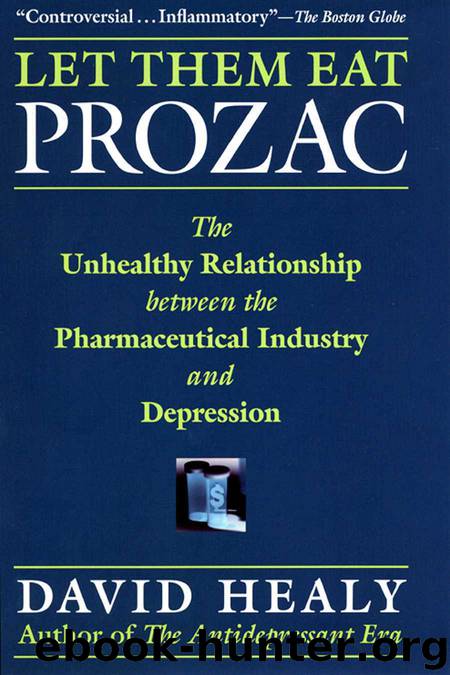Let Them Eat Prozac: The Unhealthy Relationship Between the Pharmaceutical Industry and Depression (Medicine, Culture, and History) by Healy David

Author:Healy, David
Language: eng
Format: epub
Publisher: NYU Press
Published: 2004-05-31T16:00:00+00:00
6
Kafka’s Castle
WHEN THE PROZAC CONTROVERSY first took shape, Lilly responded by meta-analyzing its clinical trials database—or so it seemed. Lilly brought this evidence to the FDA hearing that “cleared” Prozac in 1991, and the company confronted Martin Teicher with it at an ACNP meeting in December 1991. Finally, this was the evidence published in the British Medical Journal, with Charles Beasley as first author, in September 1991, just as the FDA hearing on Prozac took place.1 Perhaps more than anything else, this article influenced the events that followed. For many, the science was on Lilly’s side.
Lilly had consulted widely with senior figures in psychopharmacology in the United States and Europe; so when the article was published, it would have influential support. It was first submitted to the New England Journal of Medicine, which sent it back stating that its readers would not be interested.2 The BMJ then agonized over publication, since the document had an entirely company authorship line.
The Beasley article represented itself as a meta-analysis of randomized controlled trials undertaken by the company. It claimed, “Data from these trials do not show that fluoxetine is associated with an increased risk of suicidal acts or emergence of substantial suicidal thoughts among depressed patients.” Reading between the lines, the message was that this was science, compared with the anecdotes produced by Teicher and others. Which was a scientist to believe—the meta-analysis or the Teicher anecdotes? Which was a journalist going to believe?
I wrote to the BMJ to point out that the Beasley article’s dependence on item 3 of the Hamilton Scale was unjustified, and that these trials had not been designed to investigate the emergence of suicidality. What I missed at the time, obvious in retrospect, is that the analysis omitted patients who dropped out because of anxiety and agitation,3 which amounted for up to 5 percent of all subjects in the trials analyzed—about 85 of the approximately 1,700 patients who went on Prozac out of the 3,067 total. These patients, at the heart of the debate, were eliminated at the stroke of a pen.
What I didn’t know at the time was that the Lilly studies involved patients coadministered benzodiazepines in order to suppress manifestations of akathisia and suicidal ideation.4 Further, of seventeen sets of patients contained in the meta-analysis, a Dr. Cohn had enrolled six sets; others involved Louis Fabre. When Lilly filed to register Prozac in 1985, the FDA suggested work by Dr. Cohn be left out of the frame.5
Still more pertinent, John Heiligenstein and Charles Beasley, both physicians with Lilly, had reanalyzed the trial data. Their brief was to investigate suicide attempts or suicidal ideation reported in trials and to categorize events as completed suicides, suicide attempts, or “suicide gestures.” The last category was effectively invented for the purpose; the paper reported on suicides and suicide attempts but not suicidal gestures. Catherine Mesner testified that similar data had been forwarded from clinical trials in Europe to Beasley and Heiligenstein to assess and categorize, and that those analyzing the trials managed to reclassify nine out of ten suicide-related events as non-significant.
Download
This site does not store any files on its server. We only index and link to content provided by other sites. Please contact the content providers to delete copyright contents if any and email us, we'll remove relevant links or contents immediately.
Should I Stay or Should I Go? by Ramani Durvasula(6785)
Why We Sleep: Unlocking the Power of Sleep and Dreams by Matthew Walker(5642)
Fear by Osho(4085)
Flow by Mihaly Csikszentmihalyi(4052)
Rising Strong by Brene Brown(3780)
Why We Sleep by Matthew Walker(3772)
Too Much and Not the Mood by Durga Chew-Bose(3694)
How to Change Your Mind by Michael Pollan(3678)
The Hacking of the American Mind by Robert H. Lustig(3580)
Lost Connections by Johann Hari(3455)
He's Just Not That Into You by Greg Behrendt & Liz Tuccillo(3302)
Evolve Your Brain by Joe Dispenza(3051)
What If This Were Enough? by Heather Havrilesky(2945)
Resisting Happiness by Matthew Kelly(2887)
Crazy Is My Superpower by A.J. Mendez Brooks(2860)
The Courage to Be Disliked by Ichiro Kishimi & Fumitake Koga(2796)
The Book of Human Emotions by Tiffany Watt Smith(2770)
Descartes' Error by Antonio Damasio(2731)
In Cold Blood by Truman Capote(2685)
